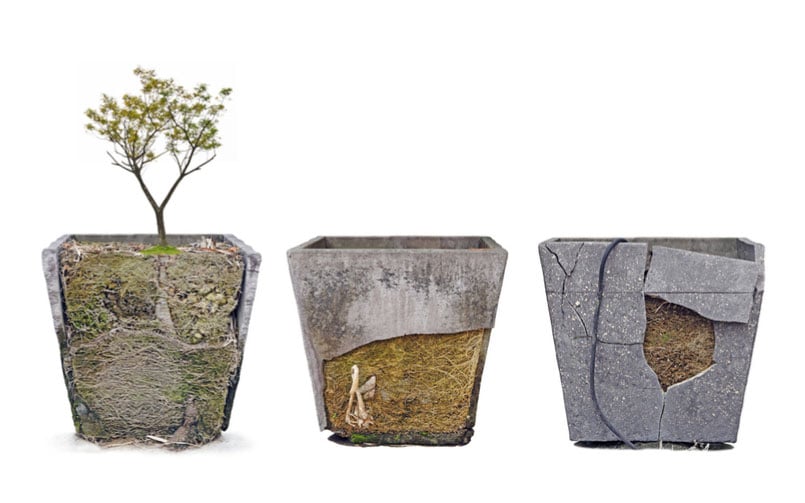Concrete planters are not the worst option for commercial spaces, after all they are durable and can last a long time under the right conditions. Although, there are some reasons to rethink adding concrete planters to commercial spaces. For one, there are more sustainable and lightweight options that are even more durable. Additionally, concrete planters are more prone to stains and require more maintenance than other options, such as resin-based planters by TerraCast.
The #1 Reason to Rethink Concrete Planters: TerraCast Planters
Our unique resin-based planters are ideal for commercial settings. They can be made to imitate the look of various materials, including stone. Flexible, lightweight, and incredibly durable, TerraCast planters easily outlast concrete planters. Plus, they require little to no maintenance.
Benefits of TerraCast planters:
- Non-hydroscopic—will not absorb moisture or stains and is therefore resistant to water damage, freeze/thaw cycles, graffiti, etc.
- Can withstand a much larger range of temperatures, -40 to 140+ degrees F
- Lightweight, our planters are 75% lighter than other planter materials such as concrete or stone. This makes them easier and less labor-intensive to move, plus they are cheaper to ship to your location.
- Resin is flexible, making planters resistant to impact damage.
- Maintenance free—materials are resistant to chips, and cracks
- Treated with a UV inhibitor to resist fading
- Fully customizable—create a custom mold or color, or add your logo
- Made right here in the USA using sustainable manufacturing processes
- Recyclable and made from recycled materials; darker planters can be made with up to 99% post-consumer recycled materials. Hence why we like to say, black is the new green!
Learn more about the benefits of resin-based planters
4 More Reasons to Rethink Concrete Planters for Commercial Spaces
1. Concrete Planters are Heavy
Perhaps one of the greatest drawbacks to concrete planters is how much they weigh. Add soil, moisture, and plants to the mix and concrete planters only get heavier with time. This can make it a challenge to relocate planters for a landscape redesign or seasonally for weather. You may need to hire a team with proper equipment to do so. On top of that, heavy planters cost more to ship on site in the first place. As mentioned above, TerraCast planters are 75% lighter than concrete planters.
2. Concrete is Prone to Cracking
Concrete experts will tell you the only thing guaranteed about concrete is that it is going to form cracks at some point. Concrete is a porous material, which means it allows moisture to move in and out of its walls. When moisture gets trapped inside of concrete it freezes and thaws based on the weather. These continuous cycles of shrinkage and expansion lead to pressure on planter walls that ultimately cause cracks. Pre-existing cracks make it even easier for water to get inside. Plus, since concrete is heavy, solid, and not flexible it tends to break on impact.
3. Concrete is Prone to Stains
Because concrete has porous qualities, it not only absorbs moisture but stains as well. If someone comes along and tags a concrete planter with graffiti, it’s going to be a true challenge to remove the ink without taking extreme measures to do so. Bird poop, dog urine, mud splatters, there are countless ways a planter can start to show stains. If these stains are not easy to remove, planters begin to show their age and require maintenance or replacement.
4. Maintenance Heavy
Concrete planters require a good deal of maintenance, starting with prep work prior to adding soil and plants. Experts recommend leaving concrete planters out in the elements for a bit before adding soil and plants. That’s because it’s best if concrete planters are rained on several times to remove additives, dyes or other toxins. These additives can otherwise influence soil pH levels in a way that is negative to plants, veggies, etc.
As mentioned before, concrete planters are prone to cracking and breaking, especially in the winter months when freeze/thaw cycles are common. Experts recommend relocating concrete planters in the winter to prevent damages. This isn’t the easiest task considering the weight and size of concrete planters. If planters remain outside in the winter, you may need to cover them for protection. Make sure there is no moisture left inside of empty concrete planters to reduce the risk of freeze/thaw cycles. Additionally, concrete planters require a sealant (added every year or so) to help protect against UV rays and other exposures.
Don’t deal with the hassles associated with concrete planters! Shop our wide selection of resin-based planters.

